Pic story of Zhenping jade carving inheritor in C China
Xinhua2024-01-28 14:16

Liu Xiaoqiang (L) instructs an apprentice at his studio in Zhenping County of Nanyang City, central China's Henan Province, Jan. 23, 2024. The Zhenping jade carving is a traditional folk art originated from Zhenping County, with Dushan jade as its primary raw material. Through more than 10 procedures, ranging from material selection, designing to carving, the raw jade is ultimately transformed into exquisite artwork that strike a delicate harmony between the natural beauty of the raw jade and its given form.
Liu Xiaoqiang, a 51-year-old jade carver, is a provincial-level intangible cultural heritage inheritor of Zhenping jade carving art, acknowledged in 2021. Many of his works are displayed at the exhibition room of his studio, including finely carved landscapes, lifelike flowers and birds, and witty figurines, each with a unique style.
"All the beautiful things in the world have the potential to be transformed into Zhenping jade carvings," Liu said.
Liu has trained over 100 jade carvers in his three-decade career life. "Preserving traditional craftsmanship shouldn't solely rely on external funds or assistance; it should keep up with times, attracting more people to engage, thereby ensuring that the arts be passed down through generations," he said. (Xinhua/Li Jianan)
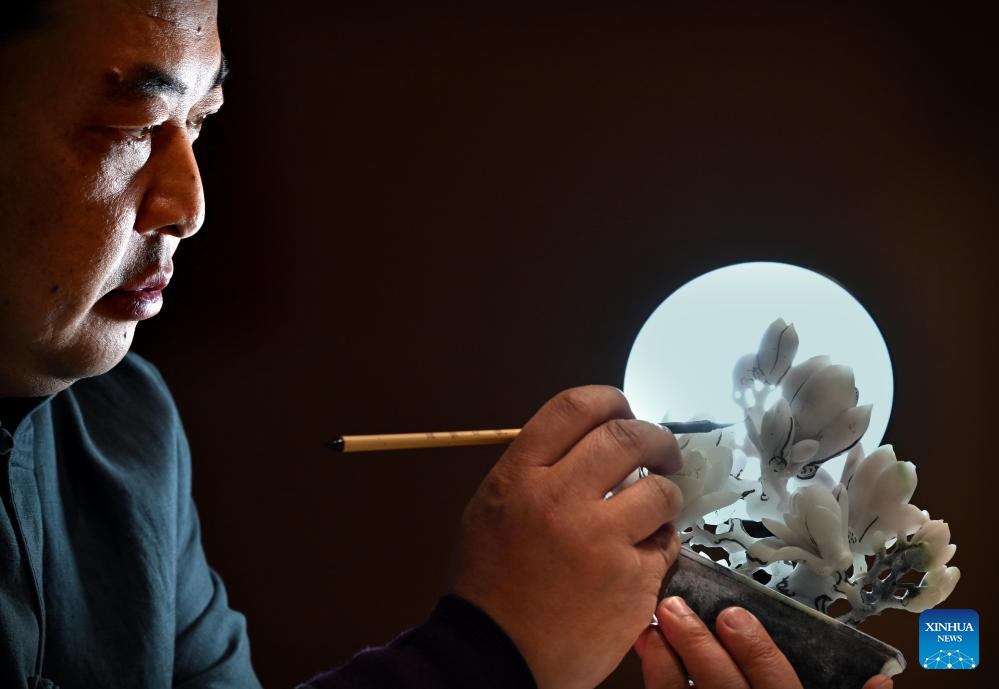
Liu Xiaoqiang conceives his next moves on an unfinished work at his studio in Zhenping County of Nanyang City, central China's Henan Province, Jan. 23, 2024. The Zhenping jade carving is a traditional folk art originated from Zhenping County, with Dushan jade as its primary raw material. Through more than 10 procedures, ranging from material selection, designing to carving, the raw jade is ultimately transformed into exquisite artwork that strike a delicate harmony between the natural beauty of the raw jade and its given form.
Liu Xiaoqiang, a 51-year-old jade carver, is a provincial-level intangible cultural heritage inheritor of Zhenping jade carving art, acknowledged in 2021. Many of his works are displayed at the exhibition room of his studio, including finely carved landscapes, lifelike flowers and birds, and witty figurines, each with a unique style.
"All the beautiful things in the world have the potential to be transformed into Zhenping jade carvings," Liu said.
Liu has trained over 100 jade carvers in his three-decade career life. "Preserving traditional craftsmanship shouldn't solely rely on external funds or assistance; it should keep up with times, attracting more people to engage, thereby ensuring that the arts be passed down through generations," he said. (Xinhua/Li An)
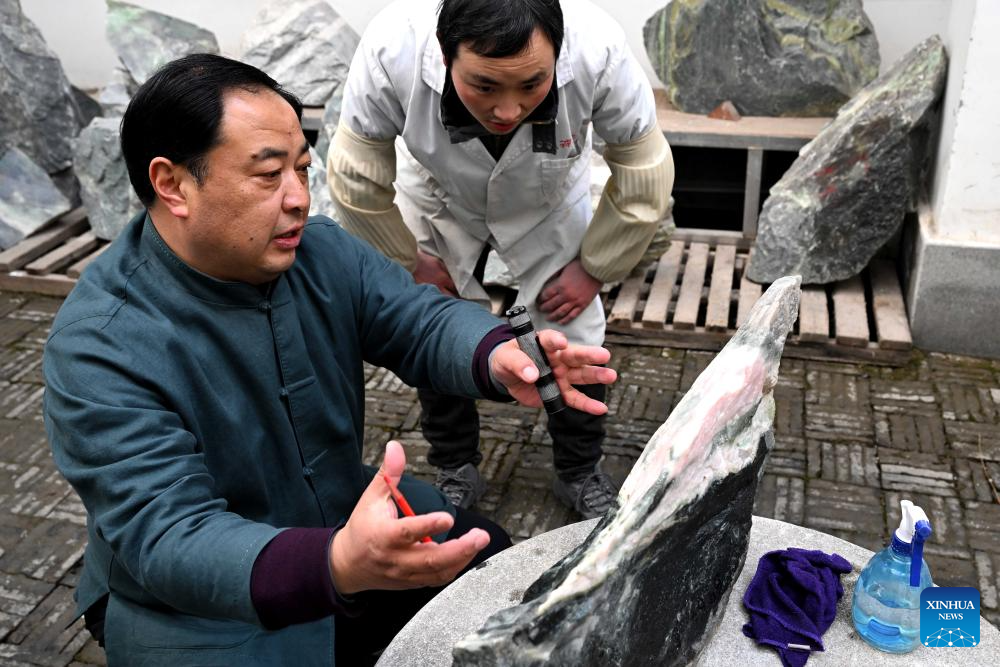
Liu Xiaoqiang (L) checks a piece of raw jade with his apprentice at his studio in Zhenping County of Nanyang City, central China's Henan Province, Jan. 23, 2024. The Zhenping jade carving is a traditional folk art originated from Zhenping County, with Dushan jade as its primary raw material. Through more than 10 procedures, ranging from material selection, designing to carving, the raw jade is ultimately transformed into exquisite artwork that strike a delicate harmony between the natural beauty of the raw jade and its given form.
Liu Xiaoqiang, a 51-year-old jade carver, is a provincial-level intangible cultural heritage inheritor of Zhenping jade carving art, acknowledged in 2021. Many of his works are displayed at the exhibition room of his studio, including finely carved landscapes, lifelike flowers and birds, and witty figurines, each with a unique style.
"All the beautiful things in the world have the potential to be transformed into Zhenping jade carvings," Liu said.
Liu has trained over 100 jade carvers in his three-decade career life. "Preserving traditional craftsmanship shouldn't solely rely on external funds or assistance; it should keep up with times, attracting more people to engage, thereby ensuring that the arts be passed down through generations," he said. (Xinhua/Li An)
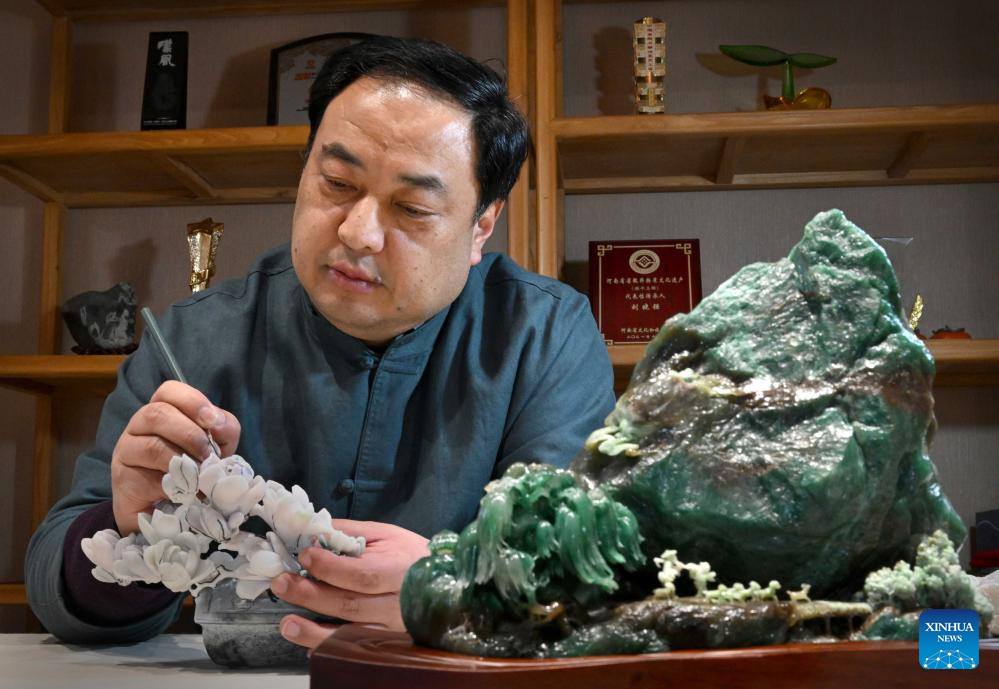
Liu Xiaoqiang conceives his next moves on an unfinished work at his studio in Zhenping County of Nanyang City, central China's Henan Province, Jan. 23, 2024. The Zhenping jade carving is a traditional folk art originated from Zhenping County, with Dushan jade as its primary raw material. Through more than 10 procedures, ranging from material selection, designing to carving, the raw jade is ultimately transformed into exquisite artwork that strike a delicate harmony between the natural beauty of the raw jade and its given form.
Liu Xiaoqiang, a 51-year-old jade carver, is a provincial-level intangible cultural heritage inheritor of Zhenping jade carving art, acknowledged in 2021. Many of his works are displayed at the exhibition room of his studio, including finely carved landscapes, lifelike flowers and birds, and witty figurines, each with a unique style.
"All the beautiful things in the world have the potential to be transformed into Zhenping jade carvings," Liu said.
Liu has trained over 100 jade carvers in his three-decade career life. "Preserving traditional craftsmanship shouldn't solely rely on external funds or assistance; it should keep up with times, attracting more people to engage, thereby ensuring that the arts be passed down through generations," he said. (Xinhua/Li An)

This combo photo taken on Jan. 23, 2024 shows jade carving artworks displayed at the exhibition room of Liu Xiaoqiang's studio in Zhenping County of Nanyang City, central China's Henan Province, Jan. 23, 2024. The Zhenping jade carving is a traditional folk art originated from Zhenping County, with Dushan jade as its primary raw material. Through more than 10 procedures, ranging from material selection, designing to carving, the raw jade is ultimately transformed into exquisite artwork that strike a delicate harmony between the natural beauty of the raw jade and its given form.
Liu Xiaoqiang, a 51-year-old jade carver, is a provincial-level intangible cultural heritage inheritor of Zhenping jade carving art, acknowledged in 2021. Many of his works are displayed at the exhibition room of his studio, including finely carved landscapes, lifelike flowers and birds, and witty figurines, each with a unique style.
"All the beautiful things in the world have the potential to be transformed into Zhenping jade carvings," Liu said.
Liu has trained over 100 jade carvers in his three-decade career life. "Preserving traditional craftsmanship shouldn't solely rely on external funds or assistance; it should keep up with times, attracting more people to engage, thereby ensuring that the arts be passed down through generations," he said. (Xinhua/Li An)
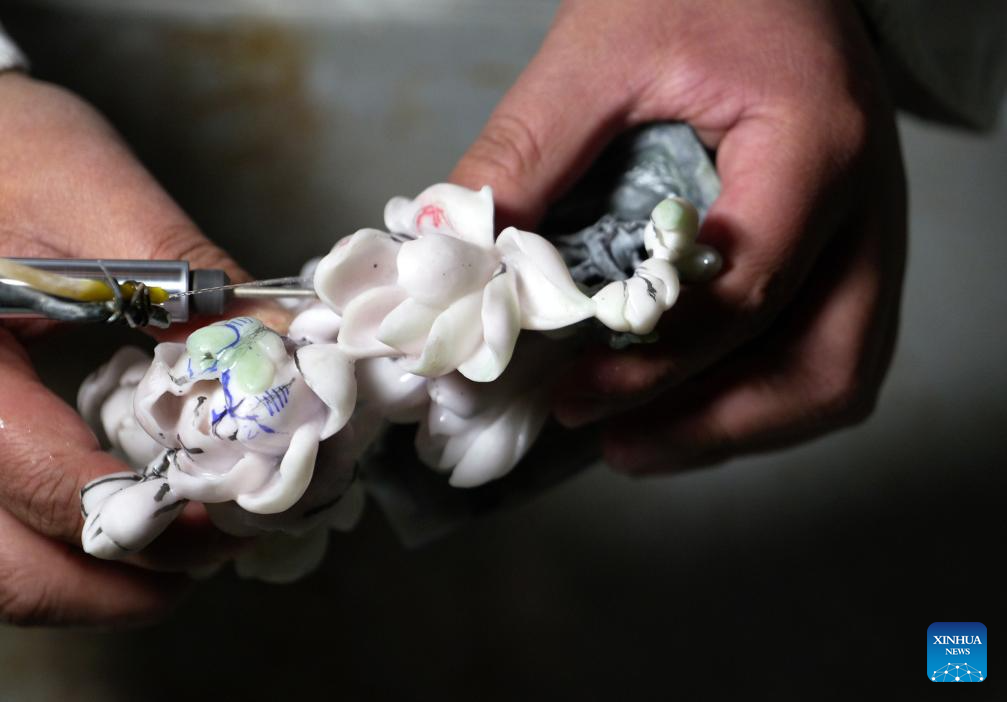
Liu Xiaoqiang carves a piece of jade at his studio in Zhenping County of Nanyang City, central China's Henan Province, Jan. 23, 2024. The Zhenping jade carving is a traditional folk art originated from Zhenping County, with Dushan jade as its primary raw material. Through more than 10 procedures, ranging from material selection, designing to carving, the raw jade is ultimately transformed into exquisite artwork that strike a delicate harmony between the natural beauty of the raw jade and its given form.
Liu Xiaoqiang, a 51-year-old jade carver, is a provincial-level intangible cultural heritage inheritor of Zhenping jade carving art, acknowledged in 2021. Many of his works are displayed at the exhibition room of his studio, including finely carved landscapes, lifelike flowers and birds, and witty figurines, each with a unique style.
"All the beautiful things in the world have the potential to be transformed into Zhenping jade carvings," Liu said.
Liu has trained over 100 jade carvers in his three-decade career life. "Preserving traditional craftsmanship shouldn't solely rely on external funds or assistance; it should keep up with times, attracting more people to engage, thereby ensuring that the arts be passed down through generations," he said. (Xinhua/Li Jianan)
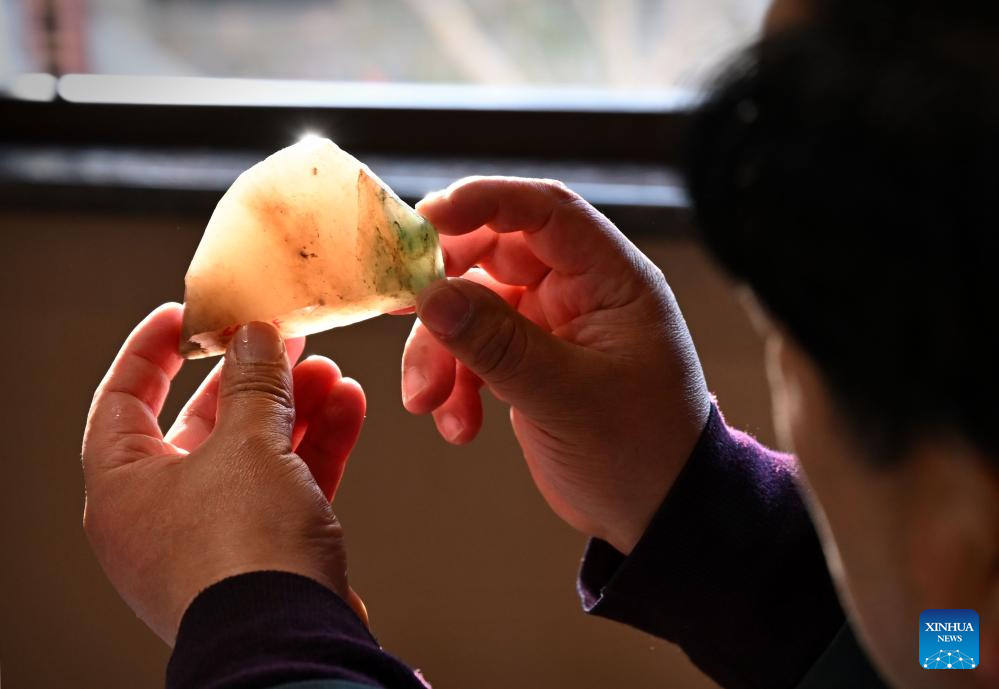
Liu Xiaoqiang checks a piece of raw jade at his studio in Zhenping County of Nanyang City, central China's Henan Province, Jan. 23, 2024. The Zhenping jade carving is a traditional folk art originated from Zhenping County, with Dushan jade as its primary raw material. Through more than 10 procedures, ranging from material selection, designing to carving, the raw jade is ultimately transformed into exquisite artwork that strike a delicate harmony between the natural beauty of the raw jade and its given form.
Liu Xiaoqiang, a 51-year-old jade carver, is a provincial-level intangible cultural heritage inheritor of Zhenping jade carving art, acknowledged in 2021. Many of his works are displayed at the exhibition room of his studio, including finely carved landscapes, lifelike flowers and birds, and witty figurines, each with a unique style.
"All the beautiful things in the world have the potential to be transformed into Zhenping jade carvings," Liu said.
Liu has trained over 100 jade carvers in his three-decade career life. "Preserving traditional craftsmanship shouldn't solely rely on external funds or assistance; it should keep up with times, attracting more people to engage, thereby ensuring that the arts be passed down through generations," he said. (Xinhua/Li An)
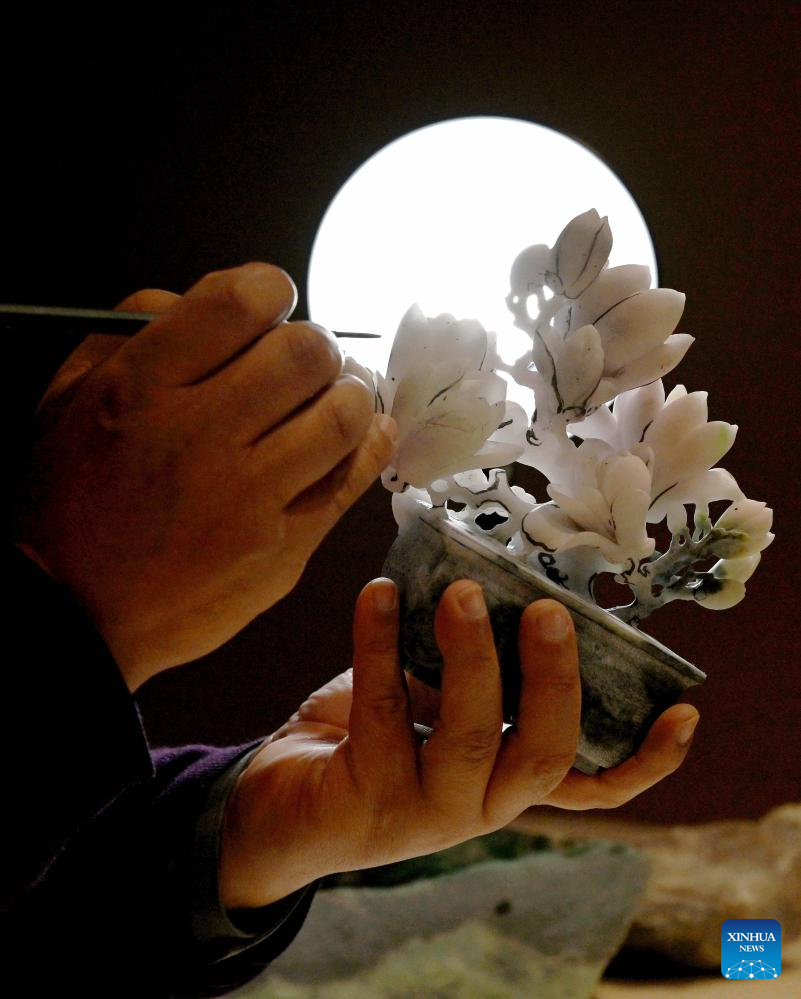
Liu Xiaoqiang conceives his next moves on an unfinished work at his studio in Zhenping County of Nanyang City, central China's Henan Province, Jan. 23, 2024. The Zhenping jade carving is a traditional folk art originated from Zhenping County, with Dushan jade as its primary raw material. Through more than 10 procedures, ranging from material selection, designing to carving, the raw jade is ultimately transformed into exquisite artwork that strike a delicate harmony between the natural beauty of the raw jade and its given form.
Liu Xiaoqiang, a 51-year-old jade carver, is a provincial-level intangible cultural heritage inheritor of Zhenping jade carving art, acknowledged in 2021. Many of his works are displayed at the exhibition room of his studio, including finely carved landscapes, lifelike flowers and birds, and witty figurines, each with a unique style.
"All the beautiful things in the world have the potential to be transformed into Zhenping jade carvings," Liu said.
Liu has trained over 100 jade carvers in his three-decade career life. "Preserving traditional craftsmanship shouldn't solely rely on external funds or assistance; it should keep up with times, attracting more people to engage, thereby ensuring that the arts be passed down through generations," he said. (Xinhua/Li An)
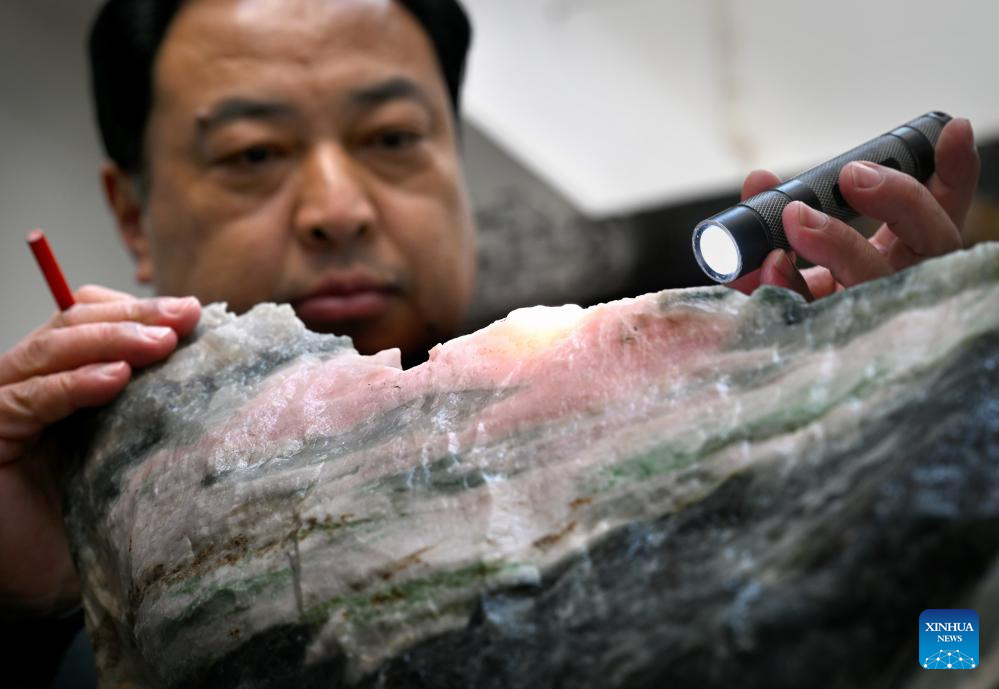
Liu Xiaoqiang checks a piece of raw jade at his studio in Zhenping County of Nanyang City, central China's Henan Province, Jan. 23, 2024. The Zhenping jade carving is a traditional folk art originated from Zhenping County, with Dushan jade as its primary raw material. Through more than 10 procedures, ranging from material selection, designing to carving, the raw jade is ultimately transformed into exquisite artwork that strike a delicate harmony between the natural beauty of the raw jade and its given form.
Liu Xiaoqiang, a 51-year-old jade carver, is a provincial-level intangible cultural heritage inheritor of Zhenping jade carving art, acknowledged in 2021. Many of his works are displayed at the exhibition room of his studio, including finely carved landscapes, lifelike flowers and birds, and witty figurines, each with a unique style.
"All the beautiful things in the world have the potential to be transformed into Zhenping jade carvings," Liu said.
Liu has trained over 100 jade carvers in his three-decade career life. "Preserving traditional craftsmanship shouldn't solely rely on external funds or assistance; it should keep up with times, attracting more people to engage, thereby ensuring that the arts be passed down through generations," he said. (Xinhua/Li An)
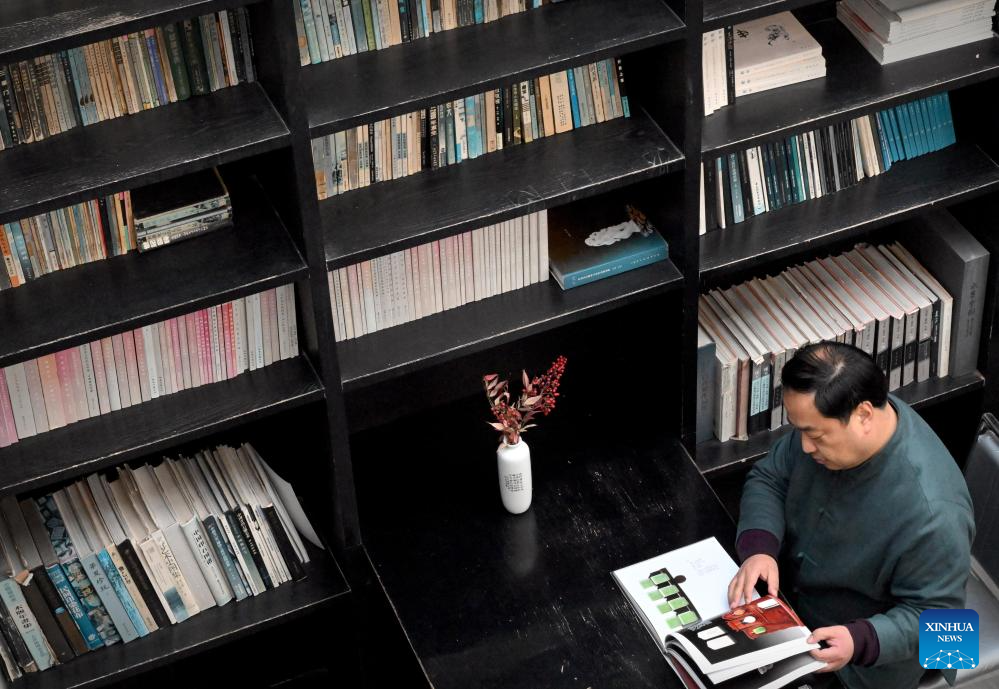
Liu Xiaoqiang reads at his studio in Zhenping County of Nanyang City, central China's Henan Province, Jan. 23, 2024. The Zhenping jade carving is a traditional folk art originated from Zhenping County, with Dushan jade as its primary raw material. Through more than 10 procedures, ranging from material selection, designing to carving, the raw jade is ultimately transformed into exquisite artwork that strike a delicate harmony between the natural beauty of the raw jade and its given form.
Liu Xiaoqiang, a 51-year-old jade carver, is a provincial-level intangible cultural heritage inheritor of Zhenping jade carving art, acknowledged in 2021. Many of his works are displayed at the exhibition room of his studio, including finely carved landscapes, lifelike flowers and birds, and witty figurines, each with a unique style.
"All the beautiful things in the world have the potential to be transformed into Zhenping jade carvings," Liu said.
Liu has trained over 100 jade carvers in his three-decade career life. "Preserving traditional craftsmanship shouldn't solely rely on external funds or assistance; it should keep up with times, attracting more people to engage, thereby ensuring that the arts be passed down through generations," he said. (Xinhua/Li An)
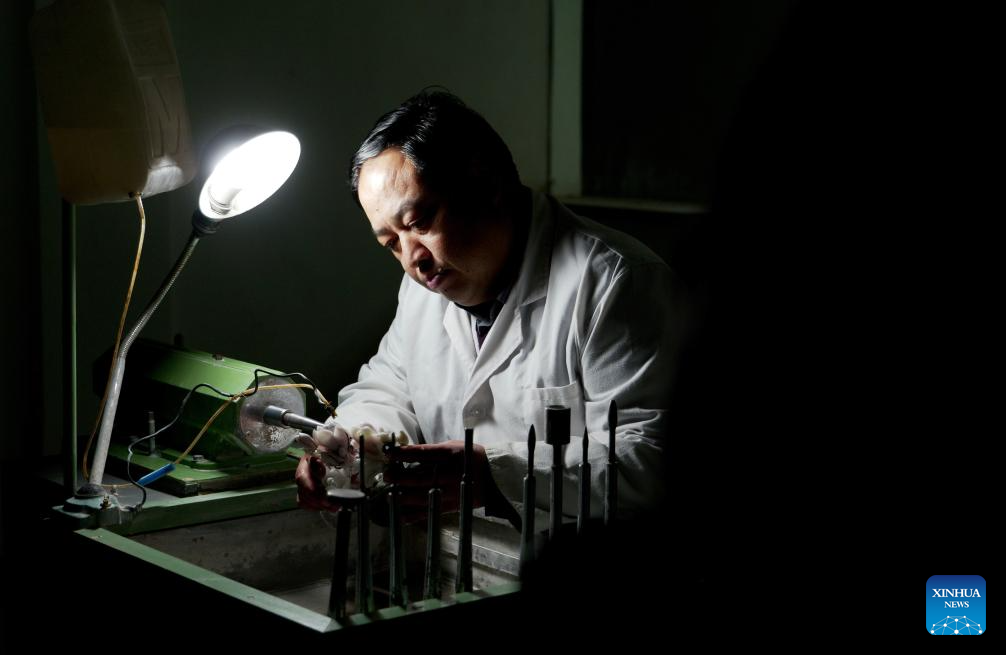
Liu Xiaoqiang carves a piece of jade at his studio in Zhenping County of Nanyang City, central China's Henan Province, Jan. 23, 2024. The Zhenping jade carving is a traditional folk art originated from Zhenping County, with Dushan jade as its primary raw material. Through more than 10 procedures, ranging from material selection, designing to carving, the raw jade is ultimately transformed into exquisite artwork that strike a delicate harmony between the natural beauty of the raw jade and its given form.
Liu Xiaoqiang, a 51-year-old jade carver, is a provincial-level intangible cultural heritage inheritor of Zhenping jade carving art, acknowledged in 2021. Many of his works are displayed at the exhibition room of his studio, including finely carved landscapes, lifelike flowers and birds, and witty figurines, each with a unique style.
"All the beautiful things in the world have the potential to be transformed into Zhenping jade carvings," Liu said.
Liu has trained over 100 jade carvers in his three-decade career life. "Preserving traditional craftsmanship shouldn't solely rely on external funds or assistance; it should keep up with times, attracting more people to engage, thereby ensuring that the arts be passed down through generations," he said. (Xinhua/Li Jianan)
